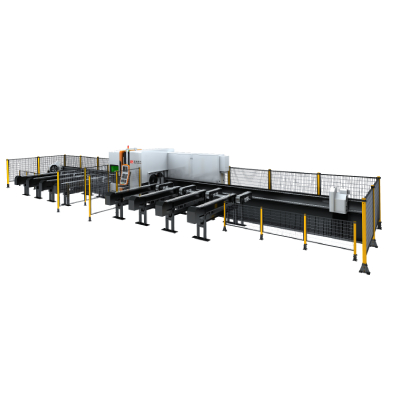****
In an era where precision, efficiency, and innovation are paramount in manufacturing and production, cutting machines have emerged as essential tools across various industries. From automotive and aerospace to fashion and woodworking, these automated devices play a crucial role in increasing productivity while ensuring high-quality outcomes. This article delves into the diverse applications of cutting machines, showcasing their importance in modern manufacturing and discussing the latest innovations in this field.
Understanding Cutting Machines

Exploring the Versatile Applications of Cutting Machines in Various Industries: A Comprehensive Guide to Their Benefits and Innovations
Cutting machines are specialized equipment designed to slice materials into desired shapes or sizes using different methods. These machines can employ blades, lasers, water jets, or plasma to perform their tasks, depending on the material being processed. The versatility of cutting machines allows them to work with various materials, including metals, plastics, textiles, and even paper.
Types of Cutting Machines
1. **Laser Cutting Machines**: Laser cutting provides precision cutting by using a high-powered laser beam to melt or vaporize materials. This technology is popular in industries requiring intricate designs, such as aerospace and jewelry manufacturing. Laser cutting offers clean edges and minimal waste, making it economically advantageous.
2. **Waterjet Cutting Machines**: Waterjet cutting utilizes high-pressure water mixed with abrasive materials to cut through tough substances like steel, stone, and glass. The primary advantage of waterjet cutting is its ability to cut delicate items without introducing heat, thus preventing warping or damage.
3. **Plasma Cutting Machines**: Plasma cutting involves using a plasma torch to cut through electrically conductive materials such as metal. This method is known for its speed and ability to cut thick materials efficiently. Plasma cutters are widely used in the automotive and manufacturing sectors.

Exploring the Versatile Applications of Cutting Machines in Various Industries: A Comprehensive Guide to Their Benefits and Innovations
4. **Die Cutting Machines**: Commonly used in the textile and packaging industries, die cutting machines stamp out specific shapes from sheet materials. This versatile machine can handle various materials, including paper, cardboard, and vinyl, making it ideal for producing consistent shapes quickly.
5. **CNC Cutting Machines**: Computer Numerical Control (CNC) cutting machines are programmed to execute intricate cutting patterns with a high degree of accuracy. These machines are essential in industries where precision is critical, such as aerospace and automotive manufacturing.
Applications Across Industries
Cutting machines have found applications across a multitude of sectors, benefiting each in unique ways:
– **Manufacturing**: In manufacturing, cutting machines enhance productivity by automating the cutting process, ensuring consistent quality, and reducing human error. This is particularly critical in producing components for automobiles and machinery, where precision is non-negotiable.
– **Textile and Fashion**: The fashion industry heavily relies on cutting machines to prepare fabric for garment production. Automated cutting systems allow designers to efficiently produce intricate patterns while minimizing fabric waste. Laser cutting, in particular, has revolutionized the textile industry by enabling detailed designs that would be difficult to achieve with traditional methods.

Exploring the Versatile Applications of Cutting Machines in Various Industries: A Comprehensive Guide to Their Benefits and Innovations
– **Construction**: In construction, cutting machines are utilized to shape and size various building materials, including wood, metal, and concrete. Advanced machinery, like CNC routers, can create complex designs for cabinetry and furniture, thereby enhancing aesthetics and functionality.
– **Signage and Graphics**: Cutting machines are essential in the signage industry for creating custom signs, graphics, and promotional materials. With their ability to cut vinyl and other substrates with precision, they allow businesses to create visually striking displays that capture customer attention.
Innovations in Cutting Machine Technology
The cutting machine industry is constantly evolving, driven by technological advancements and the need for enhanced efficiency. Recent innovations include:
– **Smart Technology**: The integration of IoT (Internet of Things) technology into cutting machines allows for real-time monitoring and maintenance. This data-driven approach helps businesses optimize performance and reduce downtime.
– **Eco-Friendly Solutions**: As environmental concerns grow, manufacturers are focusing on eco-friendly cutting solutions. Machines that minimize waste and use less energy are becoming increasingly popular, helping companies meet sustainability goals.
– **3D Cutting**: The advent of 3D cutting technology is transforming industries from manufacturing to arts and crafts. This innovative method allows for more complex and detailed designs that were previously unattainable.
Conclusion
Cutting machines are invaluable assets in modern manufacturing and production processes. Their ability to efficiently and accurately cut materials has led to significant advancements across various industries. As technology continues to evolve, so too will the capabilities of cutting machines, promising even greater efficiency, precision, and innovation in the years to come. Investing in high-quality cutting machines is no longer just an option; it is essential for businesses striving to remain competitive in an ever-changing marketplace. Steel Plate Fiber Laser Cutting Machine



